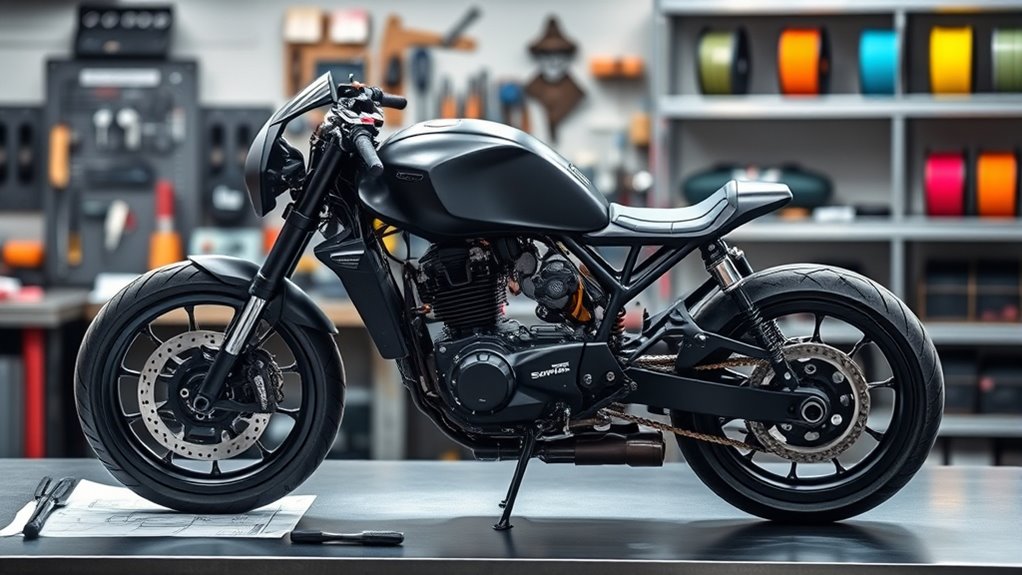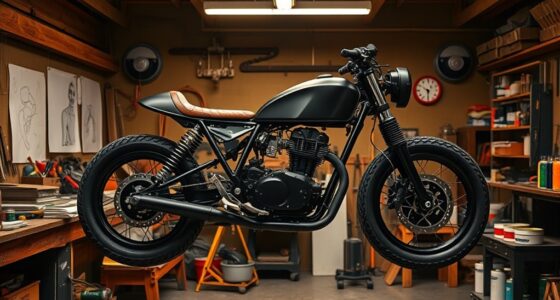3D printing transforms custom bike builds by giving you the freedom to create unique, complex shapes and optimize designs for performance. You can use innovative materials like carbon fiber or titanium, making parts lighter, stronger, and more sustainable. Hybrid manufacturing blends 3D-printed components with traditional methods for perfect fitting and functionality. This technology also cuts costs and speeds up prototyping, allowing you to customize your bike extensively. Keep exploring to discover how these advances revolutionize bike craftsmanship.
Key Takeaways
- Enables creation of complex, organic, and biomimetic bike components impossible with traditional manufacturing.
- Facilitates rapid prototyping and iterative design improvements for customized bike frames and parts.
- Allows integration of advanced materials like titanium and composites for lightweight, durable, and high-performance components.
- Supports cost-effective small-batch production and on-demand manufacturing, reducing inventory and customization costs.
- Promotes innovative hybrid designs by combining 3D printed parts with traditional manufacturing for optimized performance.
Unlocking Design Freedom With Additive Manufacturing
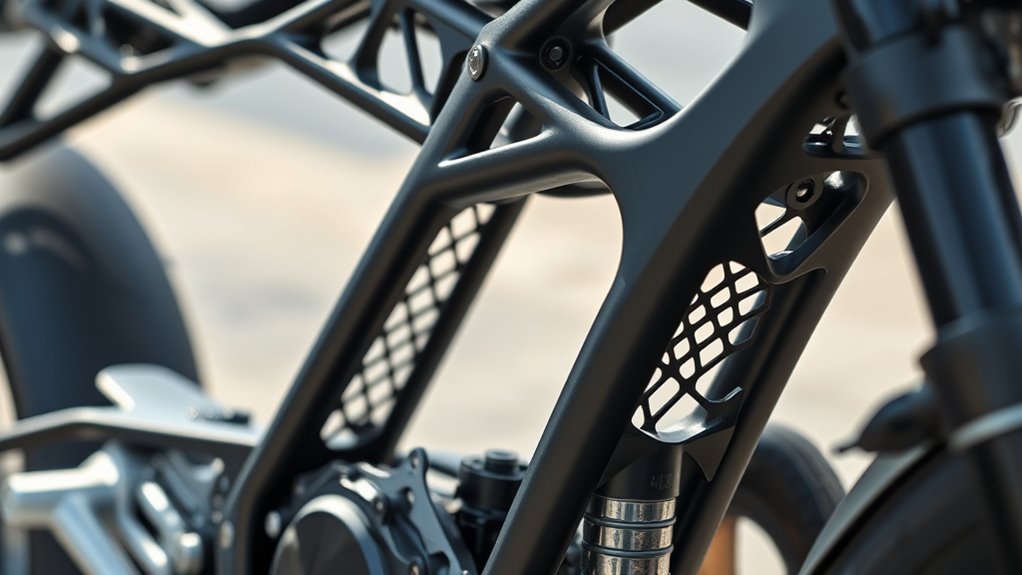
Have you ever wondered how 3D printing grants unprecedented design freedom in custom bike builds? It allows you to create organic shapes that mimic natural forms, like lattice skins and biomimetic frames, impossible with traditional methods.
Internal channels can hide cable routing and optimize airflow within solid structures, enhancing aerodynamics. Topology optimization uses AI-driven algorithms to distribute material efficiently, maximizing strength while reducing weight. Additionally, the ability to produce complex geometries enables innovative structural designs that were previously unfeasible.
Internal channels hide cables and boost airflow, making bikes more aerodynamic and efficient.
You can craft multi-axis hollow structures with curved tubes and variable wall thicknesses, which are unachievable through extrusion or welding. Additionally, 3D printing enables functional integration, combining multiple components—like derailleur hangers, bottle mounts, and sensor housings—into a single print.
Furthermore, data analytics support better decision-making in design choices, allowing for more precise customization and performance tuning. This comprehensive approach to design freedom transforms traditional constraints, making each bike uniquely tailored to your performance and aesthetic preferences.
Material Innovations Driving Sustainability and Performance

Advancements in materials for 3D printing are revolutionizing both sustainability and performance in custom bike design. By integrating carbon fiber with 3D printing, you achieve lighter, more durable components while reducing material waste. Recyclable materials further lower environmental impact by promoting reuse. Environmental sustainability is increasingly prioritized in material selection, ensuring that innovative designs align with eco-friendly practices. Topology optimization allows for lightweight yet strong structures, enhancing efficiency. Metal nodes for carbon frames streamline production and minimize waste. Customization ensures you produce only what’s needed, cutting unnecessary material use. Innovative materials like titanium and advanced polymers offer high strength-to-weight ratios and tailored performance. Hybrid materials release unique properties beyond traditional options. Additionally, ongoing developments in biodegradable composites foster even greater eco-consciousness in bike manufacturing. The use of recyclable materials also enables manufacturers to implement circular economy principles, reducing waste further. Moreover, the integration of advanced manufacturing techniques accelerates the development of sustainable bike components. Together, these innovations enable more sustainable, high-performance bikes, pushing the boundaries of what’s possible in modern custom builds.
Combining Techniques: Hybrid Approaches in Bike Fabrication
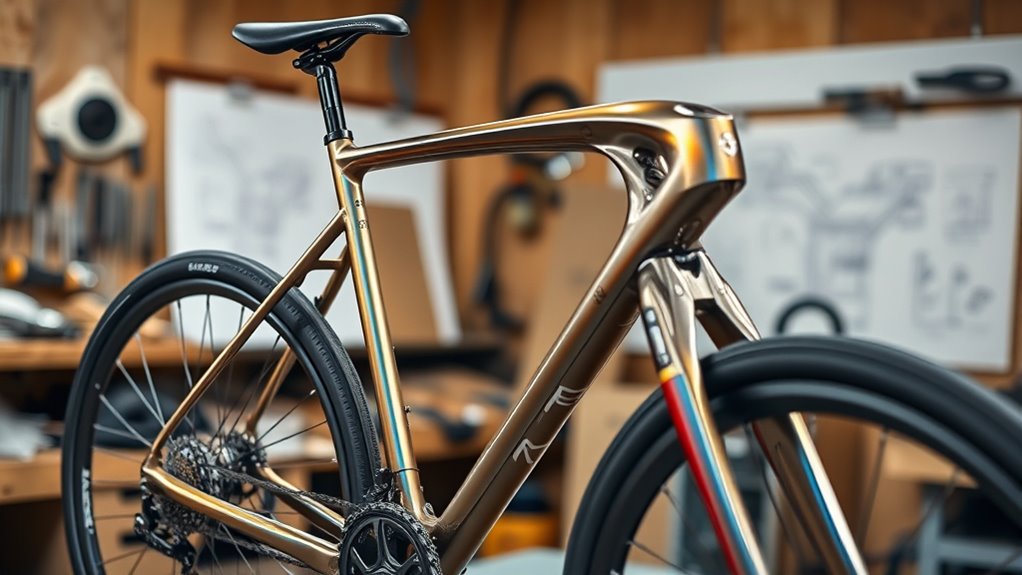
Combining different fabrication techniques unravels new possibilities for customizing bike frames and drivetrains. You can integrate composite layups with multi-material 3D printing to create lightweight, vibration-damping frames that accommodate hybrid systems.
Modular frame designs let you swap between battery packs and fuel tanks easily, optimizing energy sources for different rides.
Manufacturing workflows combining CNC machining with 3D-printed mounts streamline assembly and precision alignment, ensuring hybrid components fit perfectly.
Hybrid power systems, blending electric hub motors with traditional drivetrains, extend range and performance, while regenerative braking recovers energy during deceleration.
By optimizing weight distribution and thermal management, you enhance efficiency and rider comfort.
Advanced manufacturing methods further expand the potential for personalized, high-performance bike builds by enabling intricate designs and rapid prototyping.
These hybrid approaches enable you to craft innovative, high-performance bikes tailored to specific needs, blending modern materials and manufacturing methods seamlessly.
Cost-Effective Customization and Rapid Prototyping Solutions
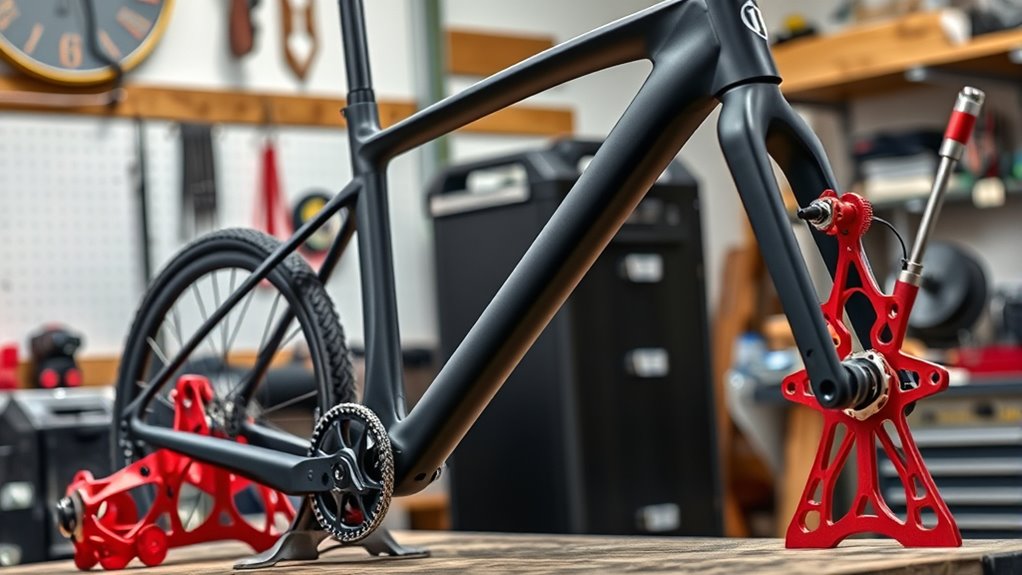
Cost-effective customization and rapid prototyping in bike building have become more accessible thanks to innovative 3D printing workflows. Without the need for molds or dies, tool-less production lowers upfront costs, especially for small batches.
3D printing workflows make bike customization affordable and rapid without molds or dies.
Digital inventories let you produce components on demand, reducing warehousing expenses. Algorithms like topology optimization cut material use by up to 33%, saving costs, while high-strength materials like Scalmalloy and titanium balance performance with affordability.
Modular designs let you upgrade parts without replacing the whole bike, further reducing costs. Rapid prototyping workflows enable quick design iterations—sometimes within days—through in-house printing and multi-material compatibility. Vetted – Halloween Product Reviews streamlines development by providing insights into various innovative materials and techniques.
Cloud collaboration and integrated failure analysis streamline development, making it easier to refine structures before production, ultimately delivering faster, more affordable customization options for your bike projects. Additionally, understanding safety in shark-infested waters is critical for those exploring marine environments. Embracing drivetrain components with 3D printing allows for tailored, lightweight, and durable parts that enhance bike performance and rider experience.
Functional Benefits of 3D-Printed Components in Riding Experience
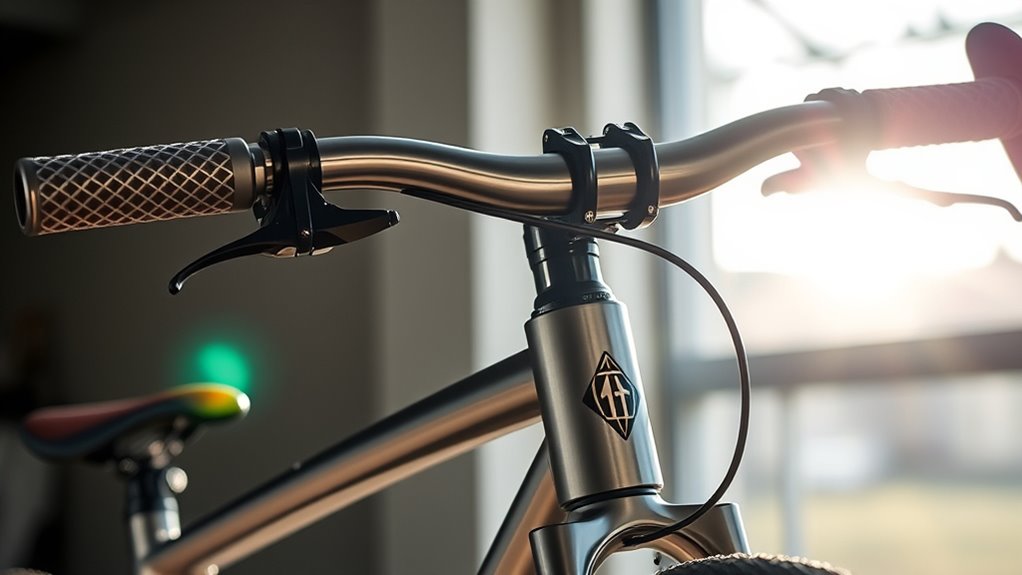
3D printing transforms your riding experience by enabling highly customized components that boost performance and comfort. You can optimize designs with complex structures that improve strength-to-weight ratios, making your bike more efficient.
Using high-performance materials like titanium, you benefit from lighter, stronger parts that enhance acceleration and climbing. Custom-fit components reduce fatigue and increase comfort, tailored precisely to your body’s unique geometry.
Rapid iteration allows you to test different designs quickly, refining performance continuously. Additionally, lattice structures minimize weight without sacrificing durability, and integrated designs reduce the number of parts, increasing reliability.
These tailored, lightweight components not only improve handling and aerodynamics but also elevate your overall riding experience by delivering better support, efficiency, and comfort.
Industry Trends and Real-World Applications in Bike Manufacturing
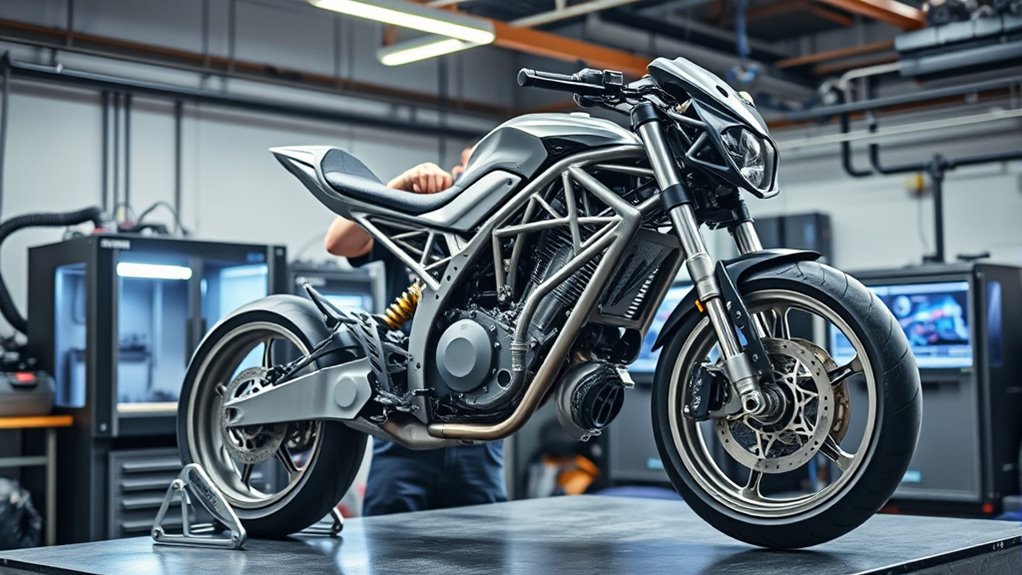
The bike industry is increasingly embracing additive manufacturing techniques to create more innovative and personalized components. You’ll notice smaller, niche brands leading the way, adopting 3D printing faster than larger companies. This technology enables rapid production of bespoke parts, tailored precisely to individual rider needs, while reducing costs and environmental impact for small batches.
Advancements in materials, like titanium, boost performance and durability. 3D printing also allows for complex geometries and high precision, producing cleaner edges and tighter tolerances. Hybrid manufacturing combines traditional methods with 3D printing to optimize both custom and mass production.
In real-world applications, companies produce end-use parts such as head tubes and connectors, mainly for high-end, bespoke bikes. Overall, these trends foster faster innovation, better customization, and more sustainable manufacturing practices.
Frequently Asked Questions
How Does 3D Printing Influence the Overall Weight of Custom Bike Frames?
You’re wondering how 3D printing impacts the weight of custom bike frames. It allows you to use lightweight materials like titanium and optimize designs for strength and minimal weight.
You can create complex geometries that reduce material usage, resulting in considerably lighter frames—sometimes by up to 45%. This technology also enables rapid prototyping and customization, helping you build bikes that are both lightweight and tailored to your performance needs.
What Are the Limitations of Current 3D Printing Materials for Bike Components?
Did you know that most 3D printed bike components face a 20-50% reduction in strength under complex load conditions?
Right now, the main limitations include lower fatigue resistance, anisotropic properties that weaken layers, and limited high-performance materials that are often costly.
These issues make it tough to rely on printed parts for critical bike components, especially when safety and durability are top priorities.
Can 3d-Printed Parts Withstand Long-Term Outdoor Exposure and Weathering?
You wonder if 3D-printed parts can endure long-term outdoor exposure and weathering. With proper material choices like ASA filament, you can achieve UV resistance and temperature stability, vital for outdoor durability.
Applying protective coatings, designing with reinforced infill, and selecting climate-specific materials help extend lifespan.
Regular inspections and hybrid constructions further ensure your bike components withstand environmental challenges, maintaining performance and appearance over time.
How Does 3D Printing Impact the Cost Comparison With Traditional Manufacturing?
You’ll find that 3D printing changes the cost game by being independent of production volume. It cuts initial costs and allows quick, cheap batch runs for customized parts.
While traditional manufacturing may be cheaper for large-scale production, 3D printing excels for small batches and complex designs without extra costs. This flexibility means you can produce unique, tailored components more economically, especially when quantity is low or designs are intricate.
Are There Specific Safety Standards for 3d-Printed Bike Parts?
Imagine riding your bike through a storm of safety standards—it’s chaotic! For 3D-printed bike parts, specific safety standards mainly focus on helmets, with strict impact resistance tests.
But when it comes to other parts like handlebars, there’s no clear regulation, leaving many in the dark. You need third-party testing to guarantee safety, as existing standards are often outdated or incomplete for these innovative, custom components.
Conclusion
As 3D printing continues to revolutionize bike building, the future holds even more exciting possibilities. Imagine discovering innovative designs and materials that could transform your riding experience forever. Are you ready to embrace these cutting-edge advancements and push the boundaries of what’s possible? The next breakthrough could be just around the corner, waiting to redefine your ride. Stay tuned—you won’t want to miss what’s coming next in the world of custom bike fabrication.
